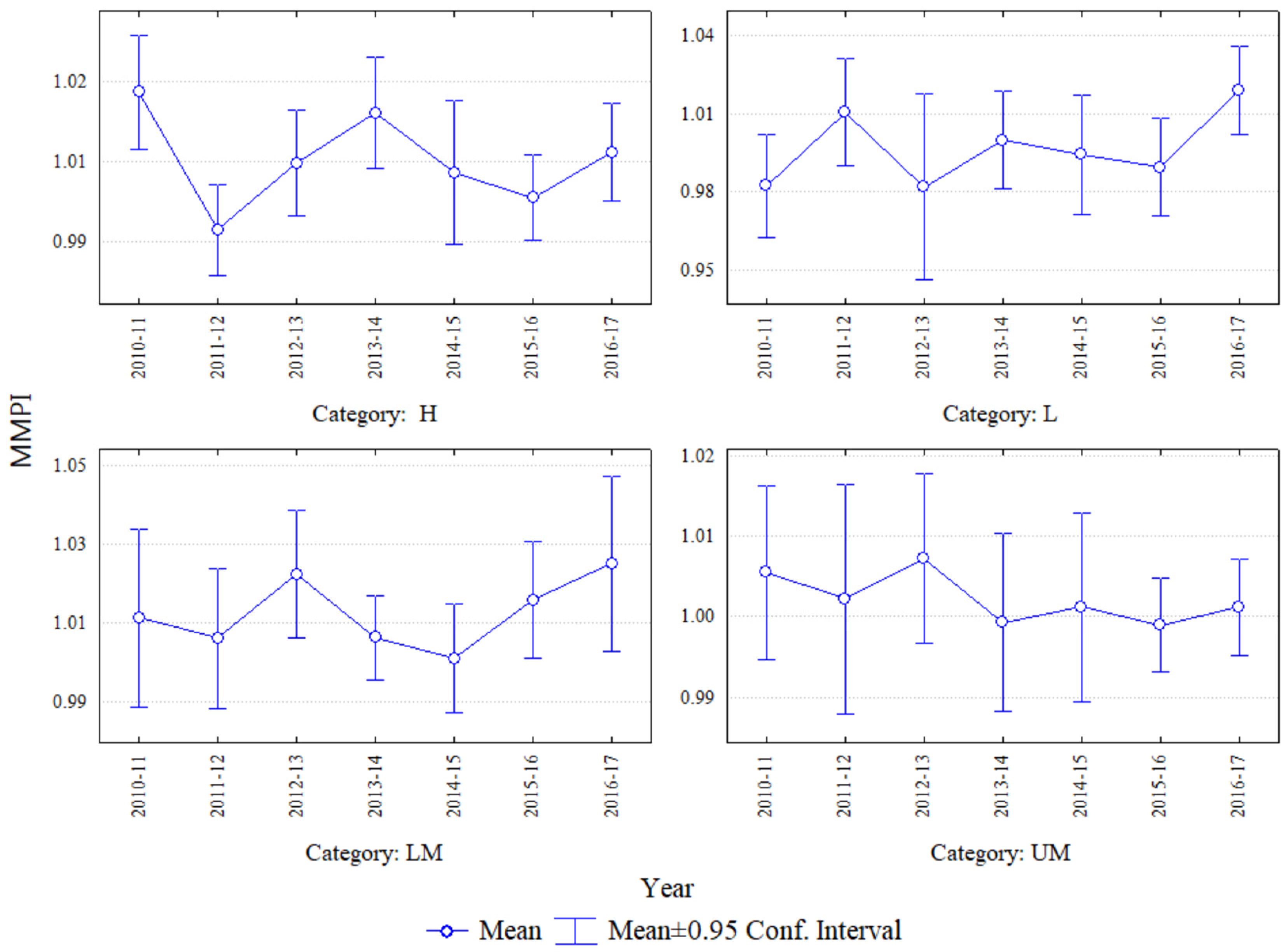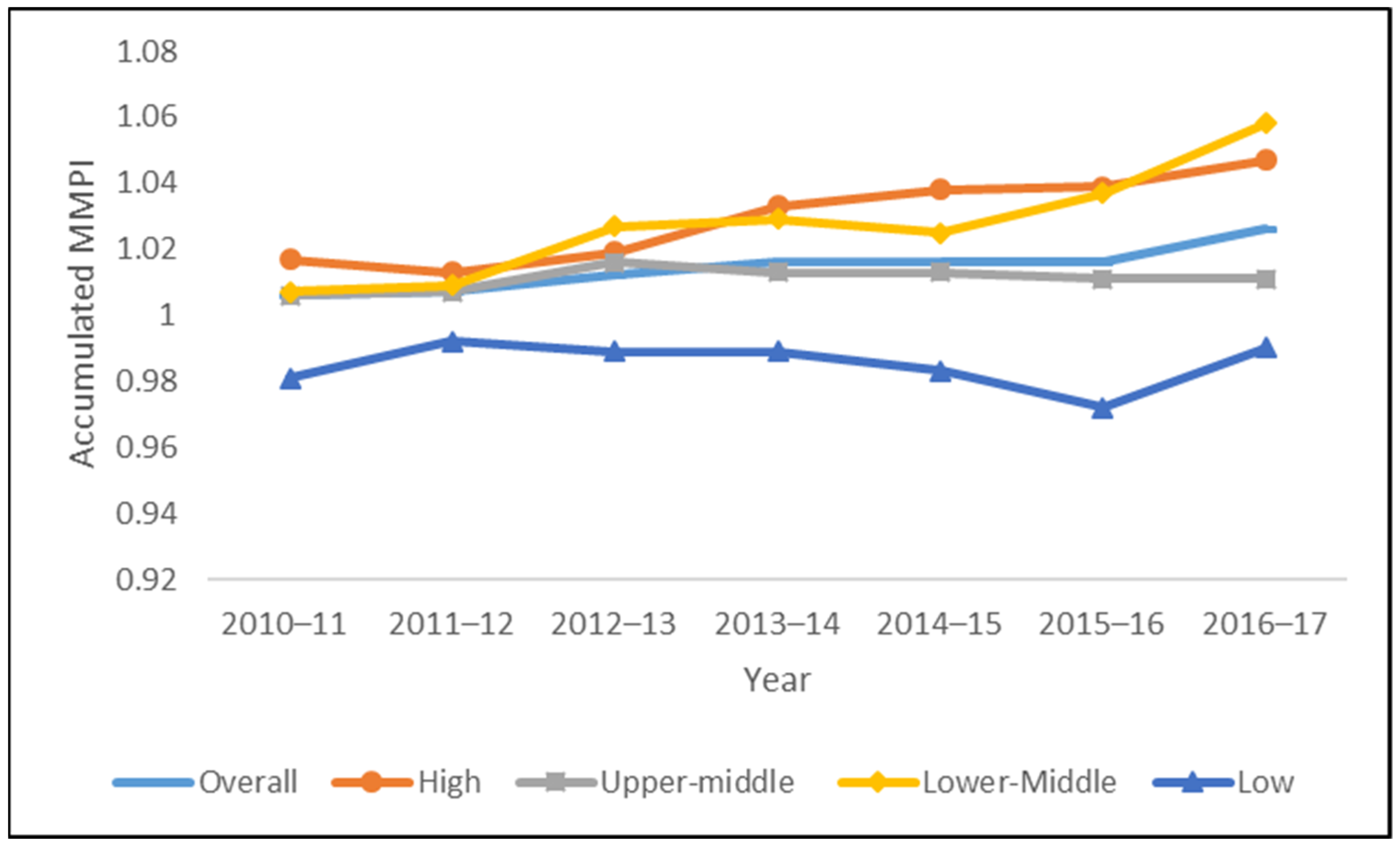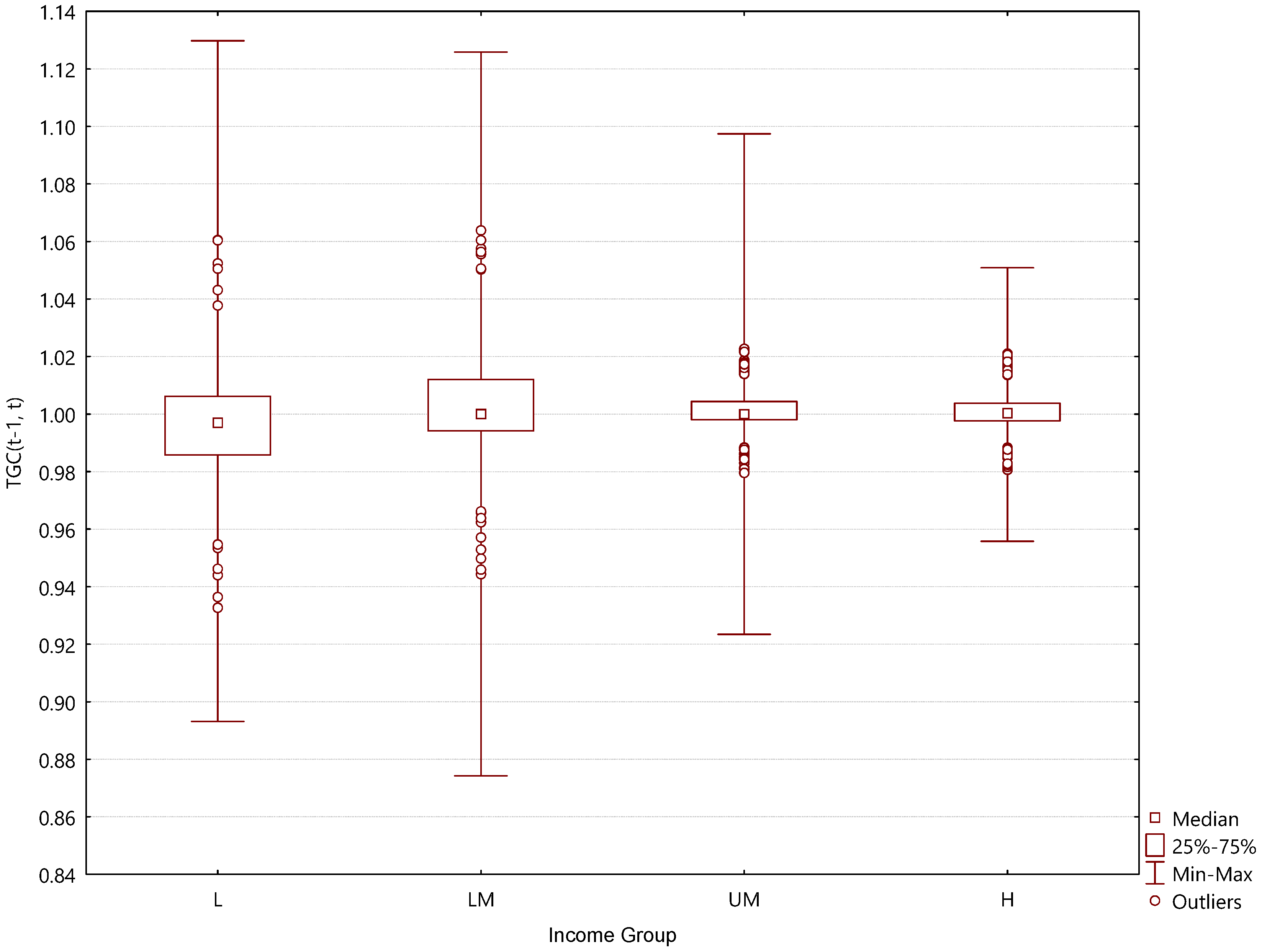2.1. Method Selection
Many of the previous environmental efficiency studies focused on the Organization for Economic Cooperation and Development (OECD) member countries [
13,
14]. Zaim and Taskin [
15] quantified the CO
2 emission efficiency of OECD countries by using a hyperbolic efficiency measure. Rashidi et al. [
16] evaluated the eco-efficiency of OECD countries incorporating non-discretionary factors. Iram et al. [
17] examined the energy efficiency of OECD countries and the connection between energy efficiency and CO
2 emissions and the environmental efficiency for several OECD countries.
The limitation of these studies lies in that they did not consider the possible technology heterogeneity. Countries around the world differ in their geographical locations and resource endowments that influence their production technologies. Countries at different developmental stages also face different pollution abatement costs [
18,
19]. The principle “common but differentiated responsibilities and respective capabilities (CBDR-RC)” (UNFCCC 1992, articles 3 and 4) established from international climate negotiations also reflects the concession and consensus in the international community. Industrialized countries and developing countries have diverged on environmental issues since the 1972 UN Conference on the Human Environment. Southern countries feared that international environmental regulations would endanger their economic growth, but several powerful developed countries, such as the United States, declined to reduce their GHG emissions unless poor countries did the same [
20]. The CBDR-RC settled the north–south climate disputes by requesting the industrialized countries to reduce their carbon emissions first and provide financial and technical assistance to the developing countries to fulfill their mitigation responsibilities.
Environmental efficiency grounded on the unrealistic assumption that countries run under the same production boundary could lead to biased results [
8,
19]. Similarly, the experience of OECD countries does not necessarily apply to countries with different income levels [
21]. Acknowledging the heterogeneities of different DMUs, recent literature employed the meta-frontier approach in assessing environmental efficiency [
22]. Chiu et al. [
8] measured the environmental efficiency in 90 countries during 2003–2007 by adopting a meta framework with directional distance function (DDF). Energy efficiency with CO
2 emissions of 63 countries for the period of 1981–2005 was measured by Lin et al. [
23], combining the meta-frontier and the DDF approach. Li and Lin [
22] also measured the environmental efficiency of 30 provinces in China using the DDF meta-frontier approach.
Zhou et al. [
24] pointed out that earlier studies about CO
2 emission performance usually lacked a time-series analysis; therefore, they introduced a Malmquist CO
2 emission performance index (MCPI) to study the world’s top 18 emitters’ MCPI over time. Chang [
25] used the Malmquist index to measure energy efficiency and its decomposition of eight Southern Africa Development Community members over time. Lin et al. [
19] employed a meta-frontier framework entrenched on the Malmquist productivity index to measure the environmental efficiency of 70 countries from 1981 to 2007.
Owing to the above considerations, this study utilizes a meta-frontier Malmquist index, which considers group heterogeneity to measure spirited changes in the environmental performance of countries from 2010 to 2017. The following section introduces the data first, and then conducts statistical tests to show the suitability of the model selection.
2.2. Data Collection
In this analysis, the data of 150 countries for 2010–2017 were collected to estimate international environmental efficiency. The inputs were three, namely, labor, capital, and energy use, one desirable output (GDP), and one undesirable output (CO
2 emissions). The variables in this study are consistent with most of the environmental efficiency research [
26]. The data were collected from the websites of the US Energy Information Administration [
27] and Penn World Table (PWT), version 9.1 [
28]. Information about the related variables is shown in
Table 1.
A DMU should minimize inputs and maximize outputs to achieve efficiency. Reducing undesirable outcomes is preferred as undesirable outcomes contradict conventional outcomes. The application of DEA for performance measurement is not an exception, so researchers have to treat undesirable outputs specially. Reviewing the analyses on undesirable outputs, Song et al. [
9] came out with three categories. The first category treated undesirable outputs as investments. The second category conducts data transformation with undesirable outputs first. Having done that, the environmental efficiency is evaluated in accordance with the traditional efficiency model based on transformed data. For example, Seiford and Zhu [
29] converted all negative undesirable outputs as positive by multiplying the negative undesirable outputs by −1 and identifying a proper translation vector. The third category is the distance function method [
30]. In addition, Cooper et al. [
31] introduced an adjusted slacks-based measure of efficiency to deal with undesirable outputs. The slacks-based measure is non-radial and non-oriented, utilizing input and output slacks directly to measure efficiency. This study adopts the first category which takes CO
2 emissions as inputs to estimate environmental efficiency.
The calculation of environmental efficiency in this study is based on a meta-frontier framework that countries do not operate under the same technology frontiers due to different characteristics, which places constraints on their feasible input–output combinations. Several researchers utilize geographical location to group countries [
32,
33,
34]. Development level is a major factor that affects the technology level of a country [
21]. Lin et al. [
19] classified a sample of countries into developed countries and developing countries, whereas Lin et al. [
23] divided 63 countries into four groups according to income level. Chiu et al. [
8] used a more sophisticated method to cluster different groups. According to the combination of the technological competitiveness indicator provided by the World Economic Forum and the average annual per capita income, four groups were identified. In this analysis, the countries were divided into four groups based on their income level according to the World Bank [
35]. The World Bank classified the world’s economies to four income groups, namely, low, lower middle, upper middle, and high, based on gross national income per capita in current US dollars and updated every year. All sample economies and their groups are illustrated in
Table 2. In this analysis, 51 economies are in the high-income group (denoted as H), 42 are in the upper-middle-income group (denoted as UM), 31 are in the lower-middle-income group (denoted as LM), and 26 are in the low-income group (denoted as L).
The descriptive statistics of all the variables among different groups are shown in
Table 3. On average, the high-income group has the most capital, whereas the lower-middle-income group has the greatest amount of labor. Generally, the high-income group relies on capital-intensive industries, whereas the lower-income group relies on labor-intensive industries. The high-income group consumes the most energy, but the upper-middle-income group contributes the most in terms of CO
2 emissions. The upper-middle-income group shows a large deviation on all the input and output variables among all groups. As expected, the low-income group has the lowest value for all the variables.
Two statistical tests were conducted to test the validity of the methodology employed in this analysis. A unique feature of DEA is that it does not require variables to match the normal distribution. With non-normal distributed samples, median values better describe the central tendency [
36], and this study conducted a normality test of all input and output variables. The results of the normality test (Kolmogorov–Smirnov test) are significant, showing that the sample variables are not normally distributed, and DEA is suitable for adoption in this study. In addition, the meta-frontier approach that assumes economies with different income levels operate under different production technology frontiers was used. To determine whether differences exist in different income groups, a non-parametric statistical analysis (Kruskal–Wallis test) is used to test the unknown distribution [
37]. The results of the Kruskal–Wallis test of all variables among high, upper middle, lower middle, and low income economies are illustrated in
Table 4. The
p-values of all variables are smaller than 0.001, indicating differences among different income groups, and justifying the applicability of a meta-frontier framework.
2.3. Methodology
The theory of Malmquist productivity index (MPI) was first introduced by Malmquist [
38]. An attractive feature of the MPI is that it can be decomposed [
39]. Several researchers, such as Caves et al. [
40], Färe et al. [
41], and Orea [
42], developed MPI in the non-parametric productivity structure.
MPI is a dynamic efficiency estimation indicator of the change in productivity of a DMU over time. If
is the efficiency of DMU
j at time
t (subscript) relative to technology frontier
t (superscript), the productivity change between period
t and
t + 1 is illustrated as
, and
t frontier is the reference frontier. Given that the reference period can be time period
t or
t + 1, MPI is the geometric mean of the distance to
t and
t + 1 frontier [
43,
44], as Equation (1):
Equation (1) shows that MPI can be decomposed into two sub-indices, namely, efficiency change and frontier change (technical change). Productivity change originates from these two indices. Efficiency change indicates the catching-up effect, whereas technical change indicates the frontier-shift (innovation) effect. The catching-up term relates to the degree to which a DMU improves or worsens its efficiency, whereas the frontier-shift term reflects the change in the efficient frontiers between the two time periods [
31].
The Malmquist index has been applied to various topics and industries, including the environmental field [
26]. Wu et al. [
45] utilized the DEA-based Malmquist index to evaluate the dynamic energy and environmental efficiency change of 30 regions in China. The Malmquist index is also used as an economic model to measure the change in the productivity of various industries, such as the non-ferrous metal industry [
46] and power plants [
47].
However, MPI only measures productivity changes across time, and the observation of different performances among DMUs with heterogeneities cannot be accomplished until the introduction of the meta-frontier concept [
32]. Meta-production functions were popularized by [
48] for the estimation of stochastic meta frontiers, and the latter was applied by [
49] to compute a global Malmquist index.
The meta-frontier Malmquist performance index (MMPI) originated from the traditional MPI and can be further decomposed into three parts: efficiency change (EC), best practice gap change (BPGC), and technology gap ratio change (TGRC). Traditional MPI solves the cross-period measurement of productivity, but it does not address the problem that the DMUs have different production technologies. This study adopts the MMPI approach that considers overall and group productivity.
This study employs the MMPI approach based on Oh and Lee [
33] to evaluate environmental efficiency changes of countries belonging to different income groups that are assumed to have different production technologies. The relevant distance measurement methods for MMPI, EC, BPGC, and TGRC are described as follows:
Assume the panel data consist of
countries and
periods, and every country uses an input vector
to generate output vector
in time
t. The production technology of all countries around the world is grounded on production possibility set
with
. In this analysis, countries are categorized into four groups according to their income level. Thus, the whole sample has four subgroups with different technological possibilities. To calculate the MMPI, Oh and Lee [
33] introduced three technology sets of contemporaneous, inter temporal, and global benchmark technology.
The contemporaneous benchmark technology of subgroup
is expressed as
with
. At each time period
t, countries with contemporaneous best technology form a production set [
49]. Supposing the similar subjects of nonnegative input and output vector under
kth group technology possibilities, the inter-temporal benchmark technology is defined as
, and output distance function
. For the specific subgroup
, countries with inter-temporal best technology form a production set including all countries in this subgroup across the whole time period.
The best production possibility set of all countries across all subgroups at all times is defined as
. This best production possibility is also noted as MMPI. The MMPI is expressed on
as Equation (2):
Output distance function
is the best production possibility set and demonstrated as Equation (3):
where TE
z and
show the countries’ technical efficiency level and best practice gap (BPG), and BPRG shows the changes in best practice gap that also can be noted as technical change. The
shows the technology gap ratio (TGR) among the
kth group’s technology relative to the overall best production possibility set (meta-frontier technology). TGR determines the distance between the
kth group’s technology and the overall frontier technology. When
, countries overlap with the meta frontier and have the potential for breakthrough innovation, making them global leaders in environmental efficiency. The technology level of the
kth group is closer to the overall meta frontier when
. TGRC shows the technology leadership change.
This study adopts linear programming to illustrate the output distance function as suggested by Färe et al. [
43,
49]. Equation (4) contends countries in the specific subgroup
k. The productivity of the
oth country of group
across time period
t and
t + 1 can be calculated and decomposed by using Equation (4) as follows:
where
demonstrates the intensity of production activity.
Equation (5) contends the countries in the specific subgroup
k across the entire research period.
is the optimal solution from Equation (4). The inter temporal distance functions are calculated by utilizing Equation (5) as follows:
Equation (6) contends all countries and subgroups over time. The
is the optimal solution from Equation (5). The global distance functions are computed as follows:









